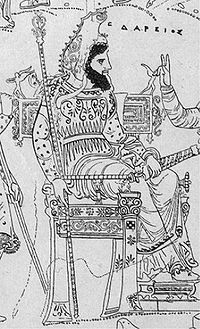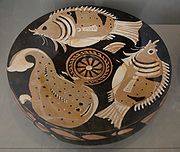
Darius Painter
Encyclopedia



Apulia
Apulia is a region in Southern Italy bordering the Adriatic Sea in the east, the Ionian Sea to the southeast, and the Strait of Òtranto and Gulf of Taranto in the south. Its most southern portion, known as Salento peninsula, forms a high heel on the "boot" of Italy. The region comprises , and...
n vase painter
Apulian vase painting
Apulian vase painting was the leading South Italian vase painting tradition between 430 and 300 BC. Of the circa 20,000 surviving specimens of Italian red-figure vases, about half are from Apulian production, while the rest are from the four other centres of production, Paestum, Campania, Lucania...
and the most eminent representative at the end of the "Ornate Style" in South Italian
South Italian
South Italian is a designation for ancient Greek pottery fabricated in Magna Graecia largely during the 4th century BC. The fact that Greek Southern Italy produced its own red figure pottery as early as the end of the 5th century BC. was first established by Adolf Furtwaengler in 1893...
red-figure
Red-figure pottery
Red-figure vase painting is one of the most important styles of figural Greek vase painting. It developed in Athens around 530 BC and remained in use until the late 3rd century BC. It replaced the previously dominant style of Black-figure vase painting within a few decades...
vase painting. His works were produced between 340 and 320 BC.
The Darius Painter's conventional name is derived from his name vase
Name vase
In classical archaeology, a name vase is a specific "vase" whose painter's name is unknown but whose workshop style has been identified. The painter is conventionally named after the selected "name vase" that embodies his characteristic style, or for one of its distinctive painted subjects, or for...
, the "Darius Vase", which was discovered in 1851 near Canosa di Puglia and now on display at the Museo Archaeologico Nazionale
Naples National Archaeological Museum
The Naples National Archaeological Museum is a museum in Naples, southern Italy, at the northwest corner of the original Greek wall of the city of Neapolis. The museum contains a large collection of Roman artifacts from Pompeii, Stabiae and Herculaneum...
, Naples (H3253). Many of his works, mostly volute krater
Krater
A krater was a large vase used to mix wine and water in Ancient Greece.-Form and function:...
s, amphora
Amphora
An amphora is a type of vase-shaped, usually ceramic container with two handles and a long neck narrower than the body...
e and loutrophoroi
Loutrophoros
A loutrophoros is a distinctive type of Greek pottery vessel characterized by an elongated neck with two handles. The loutrophoros was used to hold water during marriage and funeral rituals, and was placed in the tombs of the unmarried...
, are of large dimensions. He most frequently depicted theatrical scenes, especially ones from the Classical tragedies by Euripides
Euripides
Euripides was one of the three great tragedians of classical Athens, the other two being Aeschylus and Sophocles. Some ancient scholars attributed ninety-five plays to him but according to the Suda it was ninety-two at most...
, and mythological
Greek mythology
Greek mythology is the body of myths and legends belonging to the ancient Greeks, concerning their gods and heroes, the nature of the world, and the origins and significance of their own cult and ritual practices. They were a part of religion in ancient Greece...
themes. A number of mythological motifs not represented in surviving literary texts are known exclusively from his vases. On other shapes, especially pelike
Pelike
A pelike is a one-piece ceramic container similar to an amphora.It has two open handles that are vertical on their lateral aspects and even at the side with the edge of the belly, a narrow neck, a flanged mouth, and a sagging, almost spherical belly....
s, he also painted as wedding scenes, erotes
Eros
Eros , in Greek mythology, was the Greek god of love. His Roman counterpart was Cupid . Some myths make him a primordial god, while in other myths, he is the son of Aphrodite....
, women, and dionysiac motifs. In contrast to other contemporary painters, sepulchral scenes (naiskos vases) by him are rare; where such motifs occur, they are virtually always on the back of the vessel. Some of his paintings, like those on the Darius Vase itself, show historical subjects.
One of the most striking features of his work is the frequent use of inscriptions. He does not limit these to the normal practice of naming individual figures, but also uses them thematically (such as persai - Persians). To some extent these inscriptions can be seen as "titles". He also tends to use all available space on a vase for figural depictions, often arranged in two or three registers. Sometimes, the individual zones are structured by opulent ornamental friezes. The Darius Painter is considered the first painter to have fully exploited the possibilities of large-format vase painting. His drawing style is reputed to be especially good, particular as regards faces, which he often depicts in a three-quarter profile.
The Darius Painter worked in a large manufactory-like workshop, probably at Taras
Taras
Taras may mean:* Taras, ancient city of Magna Graecia, modern Taranto.* Taraš, a village in Vojvodina, Serbia.* Taras , the son of Poseidon and of the nymph Satyrion....
. It is possible that he was the owner or foreman of his workshop. Many vase-paintings are so close to his style, though not by his hand, that they are attributed to his workshop. He was the last important vase-painter in Apulia; Apulian vase painting
Apulian vase painting
Apulian vase painting was the leading South Italian vase painting tradition between 430 and 300 BC. Of the circa 20,000 surviving specimens of Italian red-figure vases, about half are from Apulian production, while the rest are from the four other centres of production, Paestum, Campania, Lucania...
rapidly declined in quality in the third century. Stylistically, he follows after the Varrese Painter
Varrese Painter
The Varrese Painter was an Apulian red-figure vase painter. His works are dated to the middle of the 4th century BC.His conventional name is derived from the Varrese hypogeum at Canosa di Puglia, which contained several vases painted by him. In total, over 200 known vases are attributed to him...
and his group (e.g. the Painter of Copenhagen 4223), but outdoes their achievements. Contemporaries of his that did not simply produce mass wares include the Perrone Painter and the Phrixos Painter. His most important stylistic successor was the Underworld Painter. Arthur Dale Trendall
Arthur Dale Trendall
Arthur Dale Trendall AC CMG was a New Zealand-born Australian art historian and classical archaeologist whose work on identifying the work of individual artists on Greek ceramic vessels at Apulia and other sites earned him international prizes and a papal knighthood...
, a key authority on South Italian
South Italian
South Italian is a designation for ancient Greek pottery fabricated in Magna Graecia largely during the 4th century BC. The fact that Greek Southern Italy produced its own red figure pottery as early as the end of the 5th century BC. was first established by Adolf Furtwaengler in 1893...
vase painting, described the Darius Painter as the most important painter of mythological scenes within the total of the South Italian development.
Sources
- Margot Schmidt. Der Dareiosmaler und sein Umkreis: Untersuchen zur Spätapulischen Vasenmalerei, Munich: Aschendorff, 1960.
- Jean-Marc Moret. L'Ilioupersis dans la céramique italiote, les mythes et leur expression figurée au IVe siècle, Institut Suisse de Rome, 1975.
- Alexandre Cambitoglou, Arthur Dale Trendall. The Red-figured Vases of Apulia, II, Late Apulian, Oxford, 1982: p. 482-522. Bibliography.
- Christian Aellen, Alexandre Cambitoglou, Jacques Chamay. Le peintre de Darius et son milieu, Vases grecs d'Italie Méridionale, Hellas et Roma, Genf 1986.
- Arthur Dale TrendallArthur Dale TrendallArthur Dale Trendall AC CMG was a New Zealand-born Australian art historian and classical archaeologist whose work on identifying the work of individual artists on Greek ceramic vessels at Apulia and other sites earned him international prizes and a papal knighthood...
. Rotfigurige Vasen aus Unteritalien und Sizilien. Ein Handbuch. von Zabern, Mainz 1991 (Kulturgeschichte der Antiken Welt Vol. 47), ISBN 3-8053-1111-7 (p. 85-177). - Françoise-Hélène Massa-Pairault. Le Peintre de Darius et l'actualité. De la Macédoine à la Grande Grèce, in L'incidenza dell'Antico II: studi in memore di Ettore Lepore, Napoli, 1996.
- Rolf Hurschmann. Dareios-Maler, in Der Neue PaulyPauly-WissowaThe Realencyclopädie der Classischen Altertumswissenschaft, commonly called the Pauly–Wissowa or simply RE, is a German encyclopedia of classical scholarship. With its supplements it comprises over eighty volumes....
Vol. 3 (1997), col. 324. - Claude Pouzadoux, Guerre et paix en Peucétie à l'époque d'Alexandre le Molosse (notes sur quelques vases du Peintre de Darius), in Le Canal d'Otrante et la Méditerranée antique et médiévale, colloque organisée à l'Université de Paris X - Nanterre (20-21 novembre 2000), Edipuglia, Bari, 2005.

